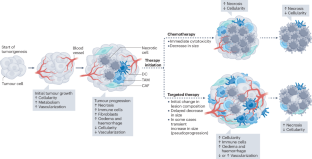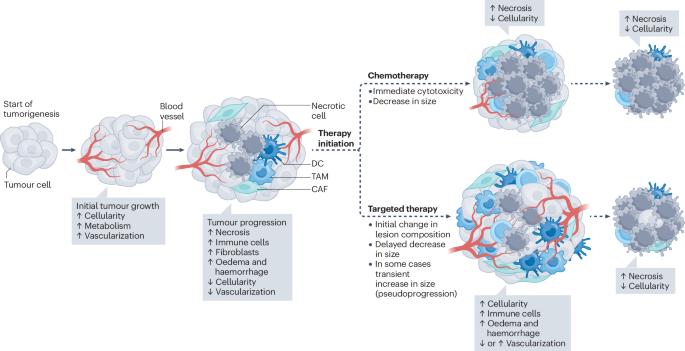用于描述肿瘤微环境特征的多参数磁共振成像技术
IF 81.1
1区 医学
Q1 ONCOLOGY
引用次数: 0
摘要
过去几十年来,我们对肿瘤生物学的认识不断发展,癌症现在被视为一个复杂的生态系统,肿瘤微环境(TME)中的各种细胞和非细胞成分在多个尺度上相互作用。然而,形态学成像仍是肿瘤分期和治疗反应评估的主要方法,而利用非侵入性成像来描述肿瘤微环境的特征尚未进入常规临床实践。多参数磁共振成像(mpMRI)结合了多种磁共振成像序列,每种序列都能提供不同但互补的 TME 信息,从而能对 TME 内的分子和细胞特征(包括其空间和时间异质性)进行无创评估。随着越来越多的先进磁共振成像技术在临床前和临床应用之间架起了桥梁,mpMRI 最终可以指导治疗方法的选择,精确地为每位患者、肿瘤和治疗方式量身定制。在这篇综述中,我们将介绍 mpMRI 在无创表征 TME 方面不断发展的作用,概述其在癌症检测、分期和治疗反应评估方面的应用,并讨论其在未来医疗应用(包括个性化综合诊断)中的注意事项和挑战。本文章由计算机程序翻译,如有差异,请以英文原文为准。


Multiparametric MRI for characterization of the tumour microenvironment
Our understanding of tumour biology has evolved over the past decades and cancer is now viewed as a complex ecosystem with interactions between various cellular and non-cellular components within the tumour microenvironment (TME) at multiple scales. However, morphological imaging remains the mainstay of tumour staging and assessment of response to therapy, and the characterization of the TME with non-invasive imaging has not yet entered routine clinical practice. By combining multiple MRI sequences, each providing different but complementary information about the TME, multiparametric MRI (mpMRI) enables non-invasive assessment of molecular and cellular features within the TME, including their spatial and temporal heterogeneity. With an increasing number of advanced MRI techniques bridging the gap between preclinical and clinical applications, mpMRI could ultimately guide the selection of treatment approaches, precisely tailored to each individual patient, tumour and therapeutic modality. In this Review, we describe the evolving role of mpMRI in the non-invasive characterization of the TME, outline its applications for cancer detection, staging and assessment of response to therapy, and discuss considerations and challenges for its use in future medical applications, including personalized integrated diagnostics. By combining multiple MRI sequences, each providing different but complementary information about the tumour microenvironment (TME), multiparametric MRI (mpMRI) enables non-invasive assessment of the heterogeneous features of the TME components. The authors of this Review describe the role of mpMRI in the non-invasive characterization of the TME, presenting examples of its utility in cancer detection, staging and assessment of response to therapy, and considering future applications for personalized integrated diagnostics.
求助全文
通过发布文献求助,成功后即可免费获取论文全文。
去求助
来源期刊
CiteScore
99.40
自引率
0.40%
发文量
114
审稿时长
6-12 weeks
期刊介绍:
Nature Reviews publishes clinical content authored by internationally renowned clinical academics and researchers, catering to readers in the medical sciences at postgraduate levels and beyond. Although targeted at practicing doctors, researchers, and academics within specific specialties, the aim is to ensure accessibility for readers across various medical disciplines. The journal features in-depth Reviews offering authoritative and current information, contextualizing topics within the history and development of a field. Perspectives, News & Views articles, and the Research Highlights section provide topical discussions, opinions, and filtered primary research from diverse medical journals.

 求助内容:
求助内容: 应助结果提醒方式:
应助结果提醒方式:


